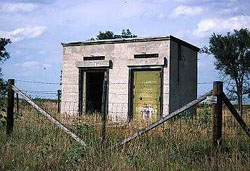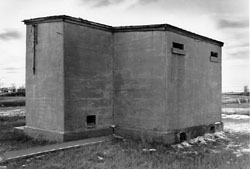
The Second-Generation Norden Bombsight Vault at the former McCook Army Air Base near McCook, Nebraska, is an example of the structures used by the military to help ensure the secrecy of this advanced technology device during World War II. The military quickly decided that strategic bombing would play an important role in the war. The Norden Bombsight was crucial in conducting that high-altitude precision strategic bombing by the U.S. Army Air Force and an essential factor in defining air war strategy. The sight was a highly accurate precision instrument developed by Carl L. Norden, a civilian consultant, and Captain Frederick I. Entwhistle, assistant research chief of the U.S. Navy's Bureau of Ordnance. In 1932 the U.S. Army Air Corps ordered its own Norden bombsight.
Charles D. Bright described the sight in his Historical Dictionary of the U.S. Air Force:"Precision bombing required meticulous control; to accomplish this, the Norden incorporated a gyrostabilized automatic pilot. The mechanism was modified in 1941 by the Minneapolis Honeywell Company and designated the Army C-1 autopilot. This modification enabled a bomber to be flown on a straight, level course, giving the bombardier a steady platform on which to operate the bombsight during the bombing run. Also known as the "Blue Ox" the Norden could quickly calculate and correct directional changes due to wind drift. Flying at a preset altitude, it could rapidly compute the correct bomb release angle for a constant speed of closure to the aiming point. Under optimal conditions on an undisturbed run, the accuracy of the device was excellent. However, any last second changes in the altitude of the bomber, such as those encountered during battle, could markedly influence the accuracy of the sight."

Because of the importance and sensitive nature of the technology, the Norden Bombsight was a closely guarded secret that required a secure area for its storage when not in use for training. Originally, Norden Bombsights were stored in a wooden building that contained five or six concrete vaults, as well as an area to test and repair the sights. After the Norden Bombsight was reclassified from secret to restricted (probably in 1943), second-generation bombsight vaults came into use. The second-generation vault stood in the open and was used solely for storage purposes. The second-generation Norden Bombsight vault at the former McCook Army Air Field is a small rectangular structure, one-story in height, 11 feet wide and 13 feet deep. It has a very slightly sloping shed-roof and one door on the main façade. The walls are 8 inches thick and the roof is also of reinforced concrete with a tar membrane. An L-shaped wing that measures five feet 10 inches by six feet eight inches is located on the southeast façade, and also has a shed-roof and a door on the main façade. Its function is unknown, though it may have housed electrical equipment. Surrounding the bombsight vault is a combination two-strand barbed wire and six-by-six woven-wire fence, supported by wooden posts. Divided into 10-foot sections, the fence extends 50 feet on each side except in the front where a 10-foot gap provides an entryway.
Nebraska, like most states, became the site of a number of military installations during World War II. There were ordnance depots and plants, and prisoner-of-war camps, but most numerous were airfields. Nebraska eventually became home to 12 air bases. Activated on April 1, 1943, the McCook Army Air Base was originally designated as a satellite field, but later became an independent facility and under the command of the 2nd Air Force, provided training for B-17, B-24 and B-29 crews. Eight different bomb groups representing the 8th, 15th and 20th Air Forces trained at the base. A total of 15,000 servicemen and 500 civilians were stationed at the field during the war. The McCook Base was deactivated on December 31, 1945, and is now in private ownership.
Visit the National Park Service Travel American Aviation to learn more about Aviation related Historic Sites.
Last updated: August 29, 2017
